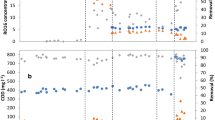Abstract
Anaerobic decolorization of anthraquinone dye represented by Reactive Blue 4 (RB4) was studied to evaluate the factors involved in dye-reducing behaviors such as dye concentration, co-substrate, treatment temperature, salt content, and dye-reducing microbial consortia. The experiment was conducted using digested sludge treated under mesophilic (35 °C) and thermophilic (55 °C) conditions. The results indicated that the thermophilic treatment gave higher potential for this dye decolorization compared with the mesophilic one. A reduced form of RB4 did not show an auto-oxidizing reaction but treated RB4 dye was shown in light yellow color, the intensity of which was related to the initial concentration of the dye used in the treatments. Starch, which showed similar decolorizing efficiency under thermophilic conditions, could be used as a co-substrate instead of glucose for the purpose of operating cost reduction. Due to the high content of salt contained in dye wastewater, the effect of salt (NaCl) was investigated. Results showed that decolorization could be accelerated with a concentration of NaCl lower than 200 mM, but the decolorization was inhibited by high concentrations of salt. The presence of RB4 inhibited methane productivity, while total organic carbon (TOC) reduction was similar to control, without dye addition. Increasing the temperature accelerated the decolorizing potential and TOC reduction. The evaluation of dye-reducing microbial consortia was done with acidogen and methanogen inhibitors which acidogenesis microorganism was dominant in RB4 decolorization.











Similar content being viewed by others
References
McMullan, G., Meehan, C., Conneely, A., Kirby, N., Robison, T., Nigam, P., et al. (2001). Applied Microbiology and Biotechnology, 56, 81–87.
O’Neill, C., Hawkes, F. R., Hawkes, D. L., Lourenco, N. D., Pinheiro, H. M., & Delee, W. (1999). Journal of Chemical Technology and Biotechnology, 74, 1009–1018.
Beydilli, I. M., Pavlostathis, S. G., & Tincher, W. C. (2000). Water Environment Research, 72, 692–705.
Epolito, W. J., Lee, Y. H., Bottomley, L. A., & Pavlostathis, S. G. (2005). Dyes and Pigments, 67, 35–46.
Pearce, C. I., Lloyd, J. R., Guthrie, S. G., & Tincher, W. C. (2003). Dyes and Pigments, 58, 179–196.
Sloker, Y. M., & Le Marechal, A. M. (1998). Dyes and Pigments, 37, 335–356.
Dos Santos, A. B., Bisschops, I. A. E., Cervantes, F., & Vanlier, J. B. (2004). Chemosphere, 55, 1149–1157.
Willets, J. R. M., & Ashbolt, N. J. (2000). Water Science and Technology, 42, 409–416.
Zollinger, H. (1991). Color chemistry (2nd ed.). New York: VHC.
Revenga, J., Rodriguez, F., & Tujero, J. (1994). Journal of the Electrochemical Society, 141, 330–333.
Correira, V. M., Stephenson, J., & Judd, S. J. (1994). Review on Environmental Technology, 15, 917–929.
Patrick, K. J. (2004). Environmental microbiology: principles and applications. Enfield: Science.
Young, L. H., Spyros, G., & Pavlostathis, S. G. (2004). Water Research, 38, 1838–1852.
Melpei, F., Andreoni, V., Daffonchio, D., & Rozzi, A. (1998). Bioresource Technology, 63, 49–56.
Delee, W., O’Neil, C., Hawks, F. R., & Pinheiro, H. M. (1998). Journal of Chemical Technology and Biotechnology, 73, 323–335.
Panswad, T., & Luangdilok, W. (2000). Water Research, 34, 4177–4184.
Acknowledgement
This study was carried out under the JSPS-NRCT Scientific Cooperation Program and supported by a Japanese government scholarship (MOMBUKAGAKUSHO: MEXT).
Author information
Authors and Affiliations
Corresponding author
Rights and permissions
About this article
Cite this article
Boonyakamol, A., Imai, T., Chairattanamanokorn, P. et al. Reactive Blue 4 Decolorization under Mesophilic and Thermophilic Anaerobic Treatments. Appl Biochem Biotechnol 152, 405–417 (2009). https://doi.org/10.1007/s12010-008-8237-9
Received:
Accepted:
Published:
Issue Date:
DOI: https://doi.org/10.1007/s12010-008-8237-9




